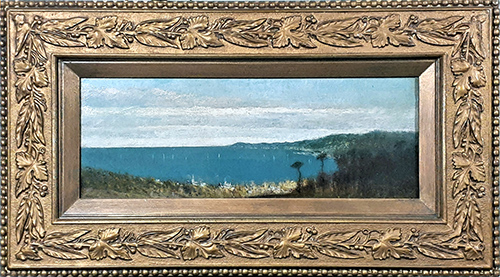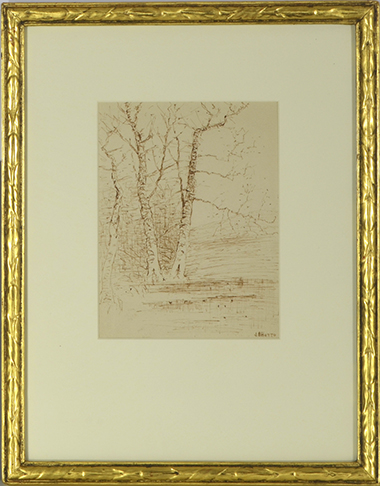John Botto (1842-1910)

Mediterranean scene
oil on canvas
signed l.r.
5 1/2 x 14 1/2 inches
10 x 20 inches frame
SOLD

untitled landscape
Ink on paper
signed l.r.
7 1/4 x 5 1/2 inches (sight)
15 x 11 5/8 inches (frame)
Our drawing was done for Charles M. Kurtz (1855-1909) to illustrate a National Academy of Design exhibition catalog, but it was never used. Kurtz, who was a close friend of Louisville artist Patty Thum and who married a Harrodsburg, Kentucky, woman, was editor of the NAD “Notes” from 1881 to 1889 and served as the director of the art department of the Southern Exposition in Louisville from 1883 to 1886.
SOLD
Louisville, Kentucky, native John Bartholomew Botto was one of the earliest Ohio Valley Tonalists. His works are few and far between, even in his native state. We know the Speed Art Museum has four, including two of the best we’ve seen, and Ashland, The Henry Clay Estate, in Lexington, Kentucky, has at least two. We’ve seen a large riverscape in a private collection – and we once saw a small harbor painting loose on the market.
Not many Louisville artists die in their country home outside Paris, leaving an estate of $150,000 to $200,000 ($4,000,000 in current cash) – and a bequest establishing a yearly art contest for Louisville schoolchildren.
This was “the son of a well-known fruit merchant” and graduate of Louisville Male High School who, early on, displayed an artistic bent. His studies took him to Europe in the 1870s. Back home, he was listed as a professional artist in the city directories of the 1870s and 1880s. He showed in the Louisville Industrial Expositions and then in every one of the successive Southern Expositions. He exhibited at the Pennsylvania Academy of the Fine Arts in Philadelphia and the National Academy of Design in New York City throughout the 1880s. As one newspaper article put it, “His pictures after a while attained recognition.”
During this period Botto “became associated” with Kentucky’s first great landscape painter, Carl Christian Brenner, who was something of a mentor to a number of local artists, including Harvey Joiner. Botto and Brenner were both members of Louisville’s burgeoning immigrant community. One article went further and called Botto “the close personal friend” of Brenner, and another identified him as a former member “of the studio of Botto & Brenner.” The two shared a love of landscape, but they were different artists. In an 1886 “Gossip of the Day” newspaper column, published two years before Brenner’s death, the writer praised Brenner and said there is no one “to take his place. John Botto’s fancy runs in another direction.”
Botto’s landscapes were described at the time as being “similar in tone; done in the cool grays and greens, those tints in the handling of which the artist is at his best.” Another correspondent wrote that Botto “is best in the portrayal of the quieter moods of nature, for which he has a fine poetic feeling. … He shows us how to find the beautiful in the homely scenery which surrounds us.”
Botto got around. He found “homely scenery” worthy of his art in Virginia, New York, Connecticut and Massachusetts. Closer to home he painted in the Floyd’s Fork, Beargrass Creek and Miami River areas, and in Rockcastle County, Kentucky, where Brenner also painted. His European paintings included Venetian lagoon scenes, images of “ruins and buildings” in France, including the Barbizon area, and in Italy. The latter were “made during a former European residence,” in the 1870s, when he studied with a student of Corot.
So why is Botto so little known now? Newspaper articles about Botto during his life always make the point that the artist wasn’t a strong self-promoter.
One article called him “perhaps the most elegant idler in the entire Louisville art colony. He only works when the inspiration moves him, and will not take up his brush until he feels that he can do full justice to the subject under consideration. As a consequence his fresh pictures are few, but those he has painted bear the impress of careful, intelligent work.” Another writer dubbed Botto “the modest and industrious Kentucky artist.”
An article about an 1886 Botto exhibition and sale stated that “Mr. Botto’s work has so infrequently been placed before the public, and he has been so modest about it withal, that most people who see the exhibition will be surprised at the very great variety and the general excellence in his painting.”
So Botto was an “idler” and “industrious.” And everyone seems to agree that he was “modest.”
Yet in that 1886 sale at Escott's Gallery in Louisville, he showed some 60 paintings, described as “landscapes and marines.” It was a major event, covered in minute detail in the local papers.
Soon after the Escott sale, Botto left Louisville to pursue his career in Paris, where, as one report put it, he “achieved renown in the French capital.” He died “at his beautiful country home at Alfortville-on-the-Seine, about fifty miles from Paris,” on April 13, 1910. He was returned home for burial in the family plot at St. Louis Cemetery.
The “modest” Botto stipulated in his will that a monument costing “not less” than $3,000 be placed on the family plot. That’s $73,000 in today’s meager money. The substantial monument features laurel leaves and an artist’s palette, brushes and maulstick. Botto left sizable amounts of cash to churches; to charitable institutions such as the Little Sisters of the Poor and the Confederate Home at Pewee Valley; to volunteer firefighter associations (his father was a volunteer fireman); and to the Italian Society (his father was a charter member). And, as mentioned, the will set up the Botto Prize, a three-tiered money award in drawing for Louisville schoolchildren.
Botto never married, but there are relatives living in Louisville.